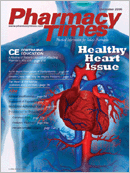Publication
Article
Pharmacy Times
WOMEN'S HEALTH WATCH
Study Shows PPD More Common,Less Treated
A recent poll of 1000 new parents in California showed that52% have either experienced postpartum depression (PPD) orknow someone who has. Surprisingly, 36% of these parentssaid they would probably do nothing about it and just wait forthe symptoms to pass on their own. This is not a good idea,considering that past studies have shown that 25% of thosewho experience PPD will still have depression after 12 monthsif they go without treatment.
PPD has been classified as a serious mental health illnessthat is able to be both properly diagnosed and treated. Leftuntreated, PPD can leave mothers at a 50% risk for futureepisodes of PPD in subsequent pregnancies, as well as at riskof harming the newborns and their older siblings.
Mental health advocates across the state were alarmed bythe findings of the poll, which was conducted by the IrisAlliance Fund, a mental health foundation. They encouragehealth care professionals to screen all new mothers for PPDduring the first year after childbirth.
IBC: The Rare, Silent Killer
There is no lump. Nothing shows up onthe mammogram. It does not even looklike cancer. Yet, it is the most aggressiveform of breast cancer; it grows faster inyounger women than other cancers, andby the time the symptoms are recognized,it will be too late for 60% of these patients.
It is called inflammatory breast cancer(IBC), and, although it accounts for about1% to 4% of all breast cancers in theUnited States, because the symptoms ofIBC can often be mistaken for other morebenign illnesses, many women may putoff seeing their doctors until the cancerhas spread, making this form of the diseaseeven more insidious.
IBC appears in sheets of cancer, orwhat doctors refer to as "cancer nests" that clog breast tissue vessels. The diseaseis characterized by thickening andredness of the breast; the skin is oftendescribed as having the appearance of anorange peel. The breast may also beenlarged, hot to the touch, and persistentlyitching, and the nipple may beinverted. Cancer experts say that earlydetection and treatment are the keys tosurvival. For more information about IBC,visit the IBC Research Foundation Website at www.ibcresearch.org.
Race a Factor in Uterine Cancer Survival
A recent study shows that black women with uterine cancerare more likely than white women to die, even though theyreceive similar treatment. The black women in the study livedan average of 10.6 months after treatment, compared with12.2 months among white women. The black women were26% more likely to die, according to researchers at Walter ReedArmy Medical Center in Washington, DC. The study findingswere published in the November issue of the journal Cancer.
The team analyzed demographic and clinical data from 1151patients who were taking part in various trials of treatment forstage 3, 4, or recurrent endometrial cancer?a cancer of thelining of the uterus. "When response to treatment was analyzed,blacks appeared to have lower tumor response to eachof the chemotherapy regimens employed in the trials," theyreported. It was noted that black patients presented for diagnosiswith more serious disease, at a point when treatment ismore difficult.
The study authors looked at patients in clinical trials whoreceived the same treatment and said the study findings "suggestthat the difference in survival is biologic, and that is consistentwith what's reported with multiple other cancers." There may be specific genes that mutate at different rates intumors in blacks, compared with whites, suggesting that biology,not socioeconomic or cultural factors, may explain the difference.They also said that the study findings suggest geneticcauses for the differences between the races.
Vaccine for Breast Cancerin the Works
A team working at Advaxis Inc (North Brunswick, NJ) isdeveloping a new line of vaccines to treat women with differenttypes of cancers, including breast cancer. A bacteriumfound in dairy products called Listeria monocytogenes is centralto the team's discovery, based on the fact that, when themicrobe is introduced into the body, it has a powerful directstimulatory effect on the activities of immune killer T cells. Theresearchers believe that, by modifying Listeria to deliver cancerantigens, they can direct that response to kill cancer cells.
In earlier studies, the team used the bacterium to deliverthe tumor-associated protein HER-2/Neu, which is overexpressedin 20% to 40% of all breast cancers, to immunecells. These cells enlist the killer T cells to seek out anddestroy the tumor cells that over-expressed the HER-2/Neumolecule.
The cancer vaccine, called Lovaxin B, is now in preclinicaltesting. Advaxis hopes to manufacture sufficient quantities ofthe vaccine and is seeking the approval of the FDA for a clinicaltrial.







